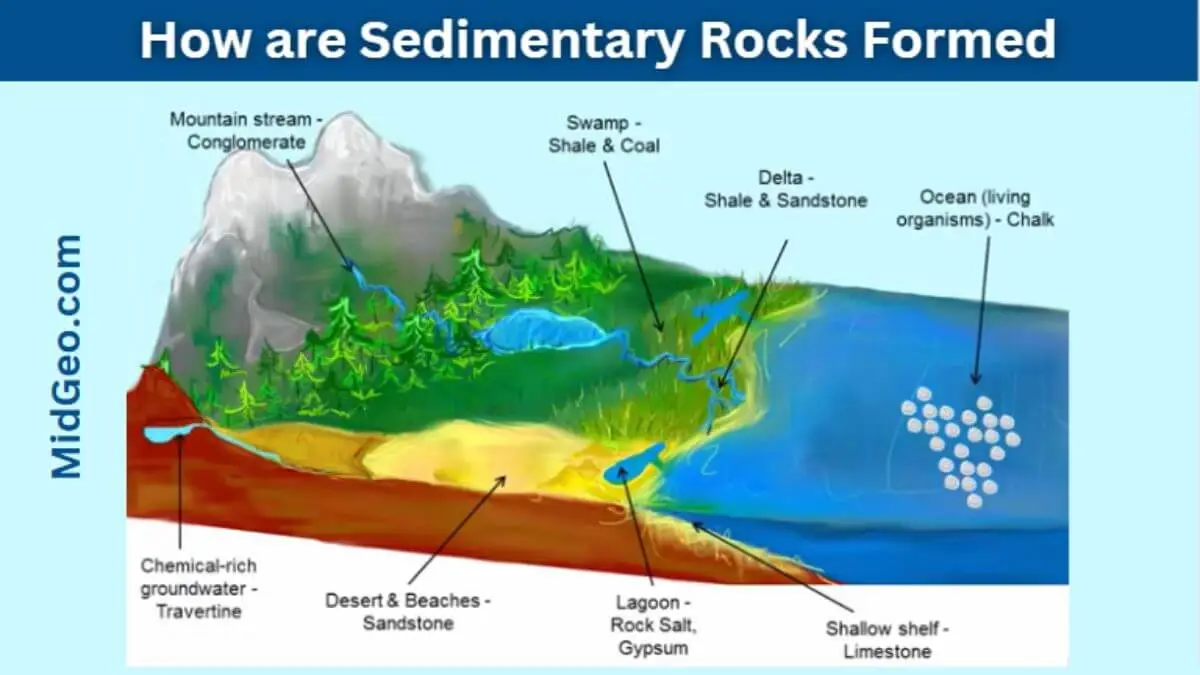
Sedimentary rocks are rocks that form from the accumulation and consolidation of sediments, such as sand, mud, and organic matter. These rocks cover about 75% of the Earth’s surface and are one of the three main types of rocks, alongside igneous and metamorphic rocks.
Sedimentary rocks are essential to geology and the study of the Earth’s history, as they provide evidence of past environments, climates, and life forms.
But how are sedimentary rocks formed? This article will explore the process of sedimentary rock formation, including the types of sedimentary rocks, examples, and the importance of these rocks.
Types of Sedimentary Rocks
Sedimentary rocks are classified into three types based on the types of sediments that form them:
- Clastic Sedimentary Rocks: These rocks are formed from the accumulation of mineral and rock fragments, such as sand, gravel, and clay. Examples include sandstone, conglomerate, and shale.
- Chemical Sedimentary Rocks: These rocks are formed from the precipitation of minerals from water. Examples include limestone, gypsum, and halite.
- Organic Sedimentary Rocks: These rocks are formed from the accumulation of organic matter, such as plant and animal remains. Examples include coal and oil shale.
- What is a Beach? How Are Beaches Formed?
- List of Landforms A to Z on Earth
- Which Land Feature Supports the Theory of Continental Drift?
- How are Sedimentary Rocks Formed: Understanding the Formation Process
- Why is a Delta Often Used as an Agricultural Area?
How are Sedimentary Rocks Formed

Formation Process of Sedimentary Rocks. The formation process of sedimentary rocks involves five main stages:
- Weathering: The first stage in the formation of sedimentary rocks is weathering, which is the breakdown of rocks and minerals into smaller fragments by physical, chemical, and biological processes.
- Erosion: The second stage is erosion, which is the transportation of the weathered fragments by wind, water, or ice.
- Deposition: The third stage is deposition, which is the settling of the transported fragments onto a surface, such as the ocean floor or a river bed.
- Compaction: The fourth stage is compaction, which is the squeezing of the deposited sediments by the weight of overlying sediments.
- Cementation: The final stage is cementation, which is the binding of the compacted sediments by natural cements, such as silica, calcium carbonate, and iron oxide.
Examples of Sedimentary Rocks:
Some examples of sedimentary rocks include:
- Sandstone: formed from the accumulation of sand grains
- Limestone: formed from the precipitation of calcium carbonate
- Shale: formed from the accumulation of clay and silt particles
- Conglomerate: formed from the accumulation of pebbles and stones
- Coal: formed from the accumulation of plant matter
What is Floodplain? How are Flood Plains Formed?
Importance of Sedimentary Rocks
Sedimentary rocks are important for several reasons:
- They provide clues about the Earth’s history and past environments, including ancient climates, landscapes, and ecosystems.
- They contain fossils, which are the remains of ancient plants and animals that lived millions of years ago. Fossils help scientists understand the evolution of life on Earth.
- They are a source of energy and mineral resources, such as coal, oil, natural gas, and metals.
Q. What is the difference between sedimentary, igneous, and metamorphic rocks?
A. Sedimentary rocks are formed from the accumulation of sediments, igneous rocks are formed from the solidification of magma or lava, and metamorphic rocks are formed from the alteration of pre-existing rocks by heat and pressure.





